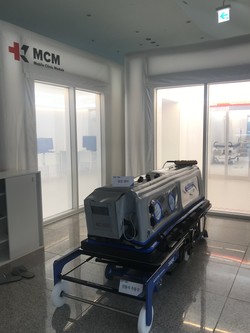
A research team led by Professor Tek-Jin Nam from the Department of Industrial Design designed an inflatable mobile negative pressure room as a response to the shortages of intense care units in hospitals amid a surge of COVID-19 cases. The module, named “KARE (Korea Aid for Respiratory Pandemic) Mobile Clinic Module (MCM)”, was developed as part of KAIST New Deal R&D Initiatives in response to COVID-19.
The MCM consists of four intensive care units (ICU), locker rooms, a nurse’s station, and a treatment room with life support machines. It includes innovative medical components, such as rubber gloves mounted on the wall. This enables medical staff to complete simple tasks such as delivering food from the outside without having to put on full protective gear every time. Not only does the MCM provide isolation facilities for patients, but also allows for providing medical treatment and monitoring symptoms for patients with moderate symptoms. The module, which is about the size of a basketball court, can be inflated within two hours but costs only 20% of conventional negative pressure beds. This allows quick and easy setup to help hospitals that are overwhelmed with the influx of COVID-19 patients. It is designed to be easily portable, requiring only 25% of the volume and 30% of the weight of traditional medical modules. The module, before inflation, can easily fit in elevators and is designed for easy transportation via airplane as well. The module offers an extremely versatile and convenient solution to the shortage of negative pressure rooms.
One of the most crucial tasks for the research team was to carefully design the airflow inside the MCM. The multi-function panel walls have positive air pressure devices that provide fresh air from the outside, and air pumps and controllers that filter the exhausted air. It also has a ventilation system that can be controlled from the outside. Since viruses like COVID-19 are transmitted through airborne particles, the ventilation system is helpful in preventing those potentially harmful particles from escaping the room. This offers another level of safety for the staff.
Moreover, the MCM has elements that prioritize the living experience of the patients. The team wanted to make a “place where people live”. Instead of the cold, white image of traditional hospital rooms, they put special effort in designing the lighting to be a warm white tone that can be modified to be different during the day and night. The beams and wirings were hidden inside the walls. Its large, clear windows allow more direct interaction between the patient and visitors, compared to traditional negative pressure rooms that only allow visitors to see the patient via CCTV cameras.
The team completed simulations in the MCM built in front of the Korea Institute of Radiological & Medical Sciences starting from December 28, 2020. They expect industrial production of the modules to begin as early as April, with the modules to be provided to hospitals on a case-by-case basis.

